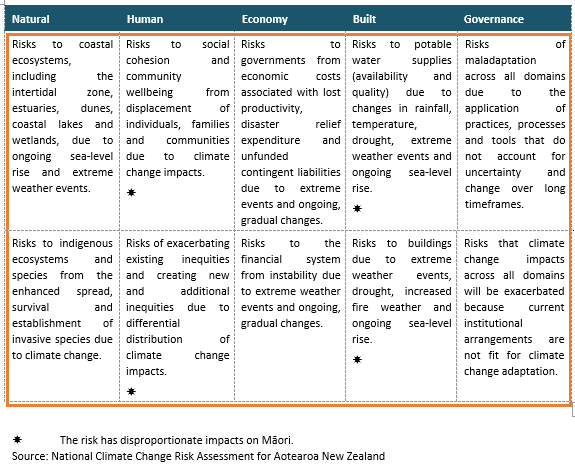Journey to net-zero heating up - Part Two
Topics covered in this article: RMA & Local Government, Sustainability & Climate Change
Special Counsel
Phone: +64 7 927 0522
Email: rzame@clmlaw.co.nz
Bachelor of Laws, Bachelor of Science, University of Otago
Journey to net-zero heating up – are you keeping on top of climate change developments?
Part Two : Draft national adaptation plan and managed retreat
Part One of this article covered the Emissions Budget and New Zealand’s first Emissions Reduction Plan.
The Ministry for the Environment (MfE) has also released New Zealand’s first national adaptation plan. It sits alongside the Emissions Reduction Plan and together they are intended to lay out New Zealand’s overall response to climate change and enable a transition to a low-emissions, climate-resilient future.
The National Adaptation Plan recognises that some of the climate impacts are already locked in and accordingly adaptation is required. The Plan focuses on addressing 43 priority risks New Zealand faces from the impact of climate change from 2020-2026, as set out in the National Climate Change Risk Assessment 2020. The 10 most significant risks are shown in the table below:
Table 1: The 10 most significant risks New Zealand will face from climate change 2020–26
The draft Adaptation Plan has three focus areas:
1. Reform institutions to be fit for a changing climate
2. Provide data, information, tools and guidance to allow everyone to assess and reduce their own climate risks
3. Embed climate resilience across government strategies and policies.
The document also includes six outcome areas:
1. System-wide actions
2. Natural environment
3. Homes, buildings and places
4. Infrastructure
5. Communities
6. Economy and financial system.
We address some of these outcome areas below.
System-wide actions
The critical actions identified include reform of the resource management system, which is to include better preparation for adaptation and risks from natural hazards, including a new Climate Adaptation Act. That Act is expected to include powers and processes to address ownership of property which is retreated from (known as ‘managed retreat’). A bill is expected to be introduced by the end of 2023.
The Government is also expected to provide a National Planning Framework to set national direction for councils in how to achieve climate resilience outcomes in the Natural and Built Environments Act (NBEA). The NBEA has not yet been introduced to Parliament as a bill, but is expected (along with the Strategic Planning Act) to be passed in 2023 and will repeal and reform the current Resource Management Act (RMA).
It also highlights work being undertaken by NIWA to provide national climate projection datasets to enable end-users to appropriately measure climate change risk, as well as the development of an Adaptation Information Portal.
Homes, buildings and places
The plan indicates that 675,000 (or one in seven) people in NZ live in areas prone to flooding, which equates to nearly $100 billion worth of residential buildings. A further 72,065 people live in areas projected to be subject to extreme sea-level rise. The number exposed will increase as climate changes.
Research is underway to inform future changes to building regulations and standards and to provide property level guidance, and an assessment framework to help owners, developers and new home builders identify climate hazards and understand adaptation requirements.
Infrastructure
This section focuses on infrastructure such as energy, telecommunications, transport, 3 Waters, waste and social infrastructure (schools, health facilities, community assets, courts, social housing etc). The purpose is to reduce the vulnerability of assets exposed to climate change, ensure all new infrastructure is fit for a changing climate and use renewal programmes to improve adaptive capacity. This includes developing a methodology for assessing impacts on physical assets and the services they provide; scoping for a resilience standard or code for infrastructure; and integrating adaptation into Treasury decisions on infrastructure.
Economy and financial sector
Between 2007-2017, contribution of climate change to floods and drought alone cost $840 million in insured damages and economic losses. In 2021 less than 10% of businesses had assessed the risk from a changing climate and less than 20% intended to take action to reduce their risks over the next 5 years.
It highlights that land-based primary industries, fisheries and aquaculture, are the most exposed industries as they depend on climate-sensitive natural resources; and failure to adapt adequately will reduce productivity and potentially viability. Impacts on regional economies and on iwi and Māori reliant on these exposed industries are also identified.
It also highlights issues relating to insurance retreat, disrupted supply chains, reduced financial stability and the fiscal impacts of extreme weather and sea-level rise.
Actions proposed include a new national Freight and Supply Chain Strategy to address resilience in the supply chain, changes to the Fisheries Act to provide more agile and streamlined decision making in response to fish stock abundance due to the effects of climate change; an Aquaculture Strategy to support industry to adapt to climate change; consideration of whether to extend mandatory climate-related disclosure requirements to public entities; and the Reserve Bank integrating climate change considerations into its supervisory, stress testing and policy work. It also includes work by the Earthquake Commission to develop options for home flood insurance issues.
Managed Retreat
Managed retreat refers to the purposeful and co-ordinated movement of people and assets away from risks.
The Ministry is also consulting on issues relating to the early development of a managed retreat system and flood insurance. That consultation document can be found here:
https://environment.govt.nz/assets/publications/Adapt-and-Thrive-consultation-document.pdf
The document dovetails into the draft National Adaptation Plan but relates more specifically to resource management reforms, legislation to support managed retreat and the development of options for home flood insurance issues.
Managed retreat at Matata (following an extreme weather event which caused significant damage) has been complex; and highlighted the need for national framework on managed retreat. The consultation document highlights the complexity associated with managed retreat, including how risks and costs associated with adaptation should be shared, what a managed retreat process should look like, whether people should be allowed to stay in areas when community services are withdrawn; as well as issues of equity, flood insurance, and managed retreat when climate change affects Māori coastal and river settlements.
Consultation is open until 3 June 2022.
If you would like further information on any of the issues raised in this article and how it might affect your business, or if you would like to make a submission on the draft National Adaptation Plan or Managed Retreat documents, contact our resource management team.
Part One covers the Emissions Budget and New Zealand's first Emissions Reduction Plan
Updated: 19 May 2022






